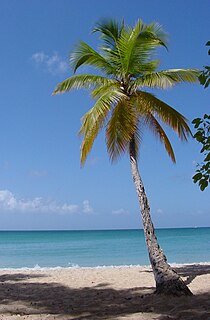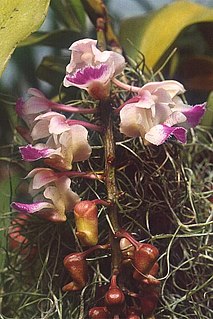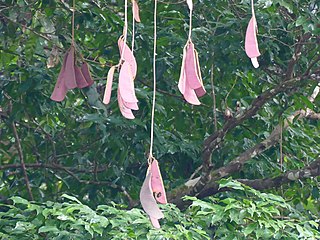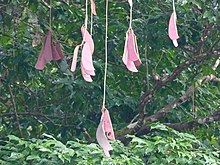
A machete is a broad blade used either as an agricultural implement similar to an axe, or in combat like a long-bladed knife. The blade is typically 30 to 45 centimetres long and usually under 3 millimetres thick. In the Spanish language, the word is possibly a diminutive form of the word macho, which was used to refer to sledgehammers., alternatively, its origin may be machaera, the name given by the Romans to the falcata. It is the origin of the English language equivalent term matchet, though it is less commonly used. In the English-speaking Caribbean, such as Jamaica, Barbados, Guyana, and Grenada and in Trinidad and Tobago, the term cutlass is used for these agricultural tools.

The Arecaceae is a family of perennial flowering plants in the monocot order Arecales. Their growth form can be climbers, shrubs, tree-like and stemless plants, all commonly known as palms. Those having a tree-like form are called palm trees. Currently, 181 genera with around 2,600 species are known, most of which are restricted to tropical and subtropical climates. Most palms are distinguished by their large, compound, evergreen leaves, known as fronds, arranged at the top of an unbranched stem. However, palms exhibit an enormous diversity in physical characteristics and inhabit nearly every type of habitat within their range, from rainforests to deserts.
2022 (MMXXII) is the current year, and is a common year starting on Saturday of the Gregorian calendar, the 2022nd year of the Common Era (CE) and Anno Domini (AD) designations, the 22nd year of the 3rd millennium and the 21st century, and the 3rd year of the 2020s decade.

Aerides, known commonly as cat's-tail orchids and fox brush orchids, is a genus belonging to the orchid family. It is a group of tropical epiphyte orchids that grow mainly in the warm lowlands of tropical Asia from India to southern China to New Guinea. They are valued in horticulture for their racemes of showy, fragrant, colorful flowers.

Quercus falcata, also called southern red oak, spanish oak, bottomland red oak or three-lobed red oak is an oak. Native to the southeastern United States, it gets its name the "Spanish Oak" as these are the areas of early Spanish colonies, whilst "southern red oak" comes from both its range and leaf color during late summer and fall. The southern red oak is a deciduous angiosperm, so has leaves that die after each growing period and come back in the next period of growth.

The subfamily Detarioideae is one of the subdivisions of the plant family Fabaceae (legumes). This subfamily includes many tropical trees, some of which are used for timber or have ecological importance. The subfamily consists of 84 genera, most of which are native to Africa and Asia. Pride of Burma and tamarind are two of the most notable species in Detarioideae. It has the following clade-based definition:
The most inclusive crown clade containing Goniorrhachis marginataTaub. and Aphanocalyx cynometroidesOliv., but not Cercis canadensisL., Duparquetia orchidaceaBaill., or Bobgunnia fistuloides(Harms) J. H. Kirkbr. & Wiersema.

Banksia falcata, commonly known as prickly dryandra, is a species of prickly, column-shaped shrub that is endemic to Western Australia. It has serrated or pinnatipartite leaves, heads of up to 150 yellow flowers and soft-hairy fruit.

Acacia falcata, commonly known as sickle wattle and by other vernacular names including sally, is a perennial shrub or tree native to eastern Australia, which reaches five metres in height and has cream flowers in early winter. It gets its common and scientific name for its sickle-shaped leaves. Hardy and adaptable to cultivation, it is used in regeneration of bushland.
Trigonella falcata is a species of plant in the family Fabaceae. It is found only in Yemen. Its natural habitats are subtropical or tropical dry forests and rocky areas.

Dryandra subg. Hemiclidia is an obsolete plant taxon that encompassed material that is now included in Banksia. Published at genus rank as Hemiclidia by Robert Brown in 1830, it was set aside by George Bentham in 1870, but reinstated at subgenus rank by Alex George in 1996. In 2007, all Dryandra species were transferred into Banksia at series rank, and the infrageneric Dryandra taxa, including D. subg. Hemiclidia, were set aside.

Eperua is a genus of flowering plants in the legume family, Fabaceae. It belongs to the subfamily Detarioideae. The fifteen species belonging to this genus are distributed in the tropical zones of Africa and South America, living in the jungles, often along rivers or streams. The leaves are compound pinnate, with smooth margins, and the fruits are long pods. The wood of E. falcata is called wallaba and is often used in construction.

Pindan is a name given to the red-soil country of the south-western Kimberley region of Western Australia. The term comes from a local language and applies both to the soil and to the vegetation community associated with it.

Dendrophthoe falcata is one of the hemiparasitic plants that belong to the mistletoe family Loranthaceae. It is the most common of all the mistletoes that occur in India. At the moment reports say that it has around 401 plant hosts. The genus Dendrophthoe comprises about 31 species spread across tropical Africa, Asia, and Australia among which 7 species are found in India.

Persoonia falcata, commonly known as the wild pear, is a shrub native to northern Australia.

Vanda falcata, the wind orchid, is a species of orchid found in China, Korea, and Japan. It was formerly classified in the genus Neofinetia.
Alafia is a genus of lianas or climbing shrubs found in tropical Africa and Madagascar. The World Checklist of Selected Plant Families recognises 26 species:

Hakea falcata, commonly known as sickle hakea, is a shrub in the family Proteacea and is endemic to southern Western Australia. It has narrow egg-shaped leaves, cream flowers and blooms in spring.

The Alto Orinoco-Casiquiare Biosphere Reserve is a UNESCO biosphere reserve in the Venezuelan Amazon biome.

The 2021–22 South-West Indian Ocean cyclone season is an ongoing event of the annual cycle of tropical cyclone and subtropical cyclone formation. The season began on 15 November 2021, and it will end on 30 April 2022, with the exception for Mauritius and the Seychelles, for which it will end on 15 May 2022. The season's first storm, Moderate Tropical Storm Ana, formed on 20 January 2022, marking the latest first storm in a Southwest Indian Ocean cyclone season ever. The second, and strongest storm of the season so far, Cyclone Batsirai, formed on 24 January, and became a long-lived and powerful storm. It cruised west, and eventually made landfall in Madagascar as a Category 3-equivalent storm. These dates conventionally delimit the period of each year when most tropical and subtropical cyclones form in the basin, which is west of 90°E and south of the Equator. However, tropical cyclones that form at any time between 1 July 2021 and 30 June 2022 will count towards the season total. Tropical and subtropical cyclones in this basin are monitored by the Regional Specialised Meteorological Centre in Réunion and unofficially by the Joint Typhoon Warning Center.

Intense Tropical Cyclone Batsirai was the strongest tropical cyclone to strike Madagascar since Cyclone Enawo in 2017, shortly after Tropical Storm Ana which heavily impacted Madagascar earlier in the same 2021–22 South-West Indian Ocean cyclone season. The second tropical disturbance, first tropical cyclone and the first intense tropical cyclone of the season, Batsirai formed from a tropical disturbance first noted on 24 January. It fluctuated in intensity and became a moderate tropical storm on 27 January, after which it unexpectedly intensified into an intense tropical cyclone. It then weakened, and struggled to intensify through the coming days due to present wind shear and dry air, where it weakened after some time. Afterwards, it entered into much more favorable conditions, and it rapidly intensified into a high-end Category 4 cyclone on the Saffir–Simpson scale while moving towards Madagascar. The storm subsequently underwent an eyewall replacement cycle for the next day, and fluctuated in intensity before making landfall in Madagascar as a Category 3 cyclone, and rapidly weakening due to the immense mountainous terrain thereafter.

















